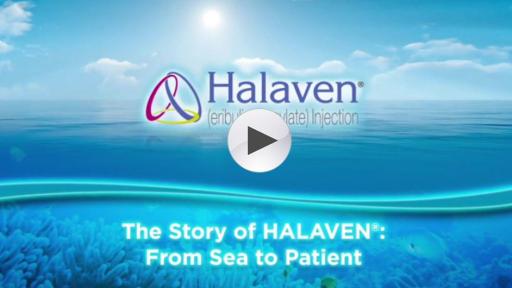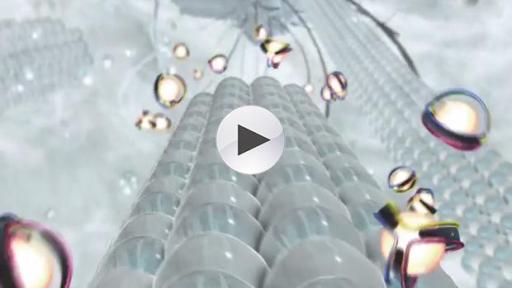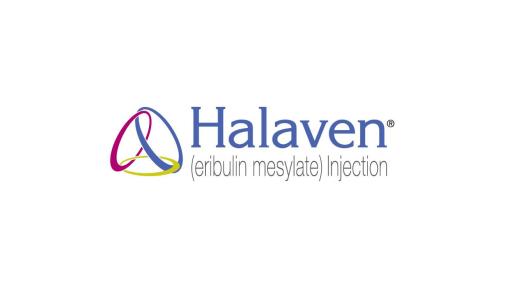Multimedia




FDA Approves Eisai’s Halaven® (eribulin mesylate) Injection for the Treatment of Patients with Advanced Liposarcoma
- Halaven is the first and only single agent to prolong overall survival in patients with previously treated advanced (unresectable or metastatic) liposarcoma in a Phase 3 trial
- With these pivotal data, Halaven is twice-proven to give more time to patients with a difficult-to-treat cancer (originally shown in metastatic breast cancer)
- Halaven was approved for advanced liposarcoma following a priority review by the FDA
PR Newswire – Woodcliff Lake, NJ, January 29, 2016
Eisai Inc. announced today that the U.S. Food and Drug Administration (FDA) approved Halaven® (eribulin mesylate) Injection (0.5 mg per mL) for the treatment of patients with unresectable or metastatic liposarcoma who have received a prior anthracycline-containing regimen. This marks the second indication for which Halaven has been approved by the FDA based on a statistically significant extension of survival.
“There is an unmet medical need for patients with soft tissue sarcoma whose disease no longer responds to treatment,” said George Demetri, MD, Professor of Medicine at Harvard Medical School and Director of the Center for Sarcoma and Bone Oncology at Dana-Farber Cancer Institute. “Halaven has been shown to help patients with advanced liposarcoma live longer, a meaningful result for patients with this rare and hard-to-treat disease.”
This approval was based on the results of the pivotal Phase 3 trial, Study 309, which demonstrated that previously treated liposarcoma patients who received Halaven (n=71) experienced a median overall survival (OS) of 15.6 months compared with 8.4 months for those who received dacarbazine (n=72) (HR 0.51; 95% CI: 0.35-0.75), making it the first single agent to demonstrate an OS benefit in this stage of the disease. Median progression-free survival (PFS), a secondary endpoint, was longer in patients with liposarcoma treated with Halaven than in those who received dacarbazine (2.9 months vs. 1.7 months; HR 0.52; 95% CI: 0.35-0.78).
“Although liposarcoma accounts for less than 1% of all malignant tumors, it is a challenging journey for patients, since diagnosis and treatment can be difficult,” said Alison Olig, Executive Director at Sarcoma Alliance. “The approval of Halaven is important for these patients, as it represents a new treatment choice where limited options have existed.”
The adverse events seen in Study 309 were consistent with the known profile of Halaven. Serious side effects from treatment with Halaven may include neutropenia, peripheral neuropathy, embryo-fetal toxicity and QT prolongation. The most common adverse reactions (incidence greater than or equal to 25%) in study patients with liposarcoma and leiomyosarcoma treated with Halaven were fatigue (62%), nausea (41%), alopecia (35%), constipation (32%), peripheral neuropathy (29%), abdominal pain (29%) and pyrexia (28%). The most common (≥5%) Grade 3-4 laboratory abnormalities reported in patients receiving Halaven were neutropenia (32% vs. 8.9% in the dacarbazine arm), hypokalemia (5.4% vs. 2.8%) and hypocalcemia (5% vs. 1.4%). The most common serious adverse reactions reported in patients receiving Halaven were neutropenia (4.9%) and pyrexia (4.5%). The most common adverse reactions resulting in discontinuation of Halaven were fatigue and thrombocytopenia (0.9% each). Additional Important Safety Information including use in specific populations is presented below.
Halaven was first approved in the United States on November 15, 2010, for patients with metastatic breast cancer who have received at least two chemotherapeutic regimens for the treatment of metastatic disease. Previous therapy should have included an anthracycline and a taxane in either the adjuvant or metastatic setting. Halaven is the first and only single agent to significantly extend overall survival in the third-line for patients with metastatic breast cancer.
“The initial approval of Halaven for metastatic breast cancer more than five years ago and today’s approval for advanced liposarcoma underscore the ability of this treatment to provide an overall survival benefit in two difficult-to-treat cancers,” said Kenichi Nomoto, Ph.D., President, Oncology Product Creation Unit, Eisai Product Creation Systems. “As a company focused on human health care (hhc), we are proud of our commitment to providing new treatment options to address the unmet medical needs of patients.”
First in the halichondrin class, Halaven is a microtubule dynamics inhibitor with a distinct binding profile. Discovered and developed by Eisai, Halaven is a synthetic analog of halichondrin B, a natural product that was isolated from the marine sponge Halichondria okadai. Based on in vitro studies, Halaven exerts its effect via a tubulin-based antimitotic mechanism, ultimately leading to apoptotic cell death after prolonged and irreversible mitotic blockage. In addition, treatment of human breast cancer cells with Halaven caused changes in cell structure and gene expression as well as decreased migration and invasiveness in vitro. Halaven treatment in preclinical models of human breast cancer was also associated with increased vascular perfusion and permeability in the tumor cores, resulting in reduced tumor hypoxia, and changes in the expression of genes in tumor specimens associated with a change in phenotype.
The FDA approved Halaven for the treatment of advanced liposarcoma following a priority review, which is designated for drugs the FDA believes, if approved, have the potential to provide a significant improvement in the safety or effectiveness of the treatment, prevention or diagnosis of a serious condition. Halaven was granted orphan drug designation for soft tissue sarcoma in the United States in May 2012.
About Study 309 in Advanced Soft Tissue Sarcoma
Study 309 was a randomized, open-label, multicenter, active-controlled trial of Halaven 1.4 mg/m2 administered intravenously (IV) on days one and eight of a 21-day cycle versus dacarbazine IV on day one, every 21 days (dose range of 850 mg/m2 to 1,200 mg/m2) to patients (n=446) with unresectable, locally advanced or metastatic leiomyosarcoma or liposarcoma following treatment with at least two systemic chemotherapies, one of which must have included an anthracycline, and disease progression within six months of the most recent chemotherapy regimen.
In this study, Halaven demonstrated a statistically significant improvement in overall survival compared to dacarbazine. Median OS in all treated patients was 13.5 months with Halaven vs. 11.3 months with dacarbazine (HR 0.75; 95% CI: 0.61-0.94; p=0.011), and PFS was 2.6 months with Halaven vs. 2.6 months with dacarbazine (HR 0.86; 95% CI: 0.69-1.06). The treatment effects of Halaven were limited to patients with liposarcoma, based on pre-planned, exploratory subgroup analyses of OS and PFS. There was no evidence of efficacy of Halaven in patients with advanced or metastatic leiomyosarcoma.
About Liposarcoma, a Type of Soft Tissue Sarcoma
Soft tissue sarcomas (STS) are cancers that develop from cells in the soft, supporting tissues of the body, such as fat, muscle, nerves, fibrous tissues and blood vessels. Approximately 12,000 new cases of soft tissue sarcoma are diagnosed each year. Liposarcoma (adipocytic soft tissue sarcoma) refers to tumors that arise from fat cells and can occur anywhere in the body. Liposarcomas make up approximately 17% of all cases of soft tissue sarcoma, accounting for about 2,000 new cases each year.
Many patients with STS, including liposarcoma, are amenable to complete surgical removal, yet relapse rates can be as high as 50%, and outcomes for patients with advanced disease are poor.
About Study 305 in Metastatic Breast Cancer (EMBRACE)
EMBRACE (Eisai Metastatic Breast Cancer Study Assessing Physician’s Choice Versus Eribulin E7389) was an open-label, randomized, global, multicenter Phase 3 study designed to compare overall survival in patients treated with Halaven (1.4 mg/m2 administered intravenously for two to five minutes on days 1 and 8 of a 21-day treatment cycle) versus a treatment of their physician’s choice (TPC) (control group). The study, which was designed to reflect a real-world clinical practice, included 762 patients with metastatic breast cancer who had been treated with an average of four prior chemotherapies.
EMBRACE met its primary endpoint of overall survival, showing that patients who received Halaven survived a median of 13.1 months (compared with 10.6 months for patients who received TPC, p=0.041). These results were consistent with an updated analysis conducted when 77% of events had occurred that showed patients who received Halaven experienced a median of 13.2 months of OS versus 10.6 months with TPC. In patients with metastatic breast cancer receiving Halaven, the most common adverse reactions (≥ 25%) were neutropenia (82%), anemia (58%), asthenia/fatigue (54%), alopecia (45%), peripheral neuropathy (35%), nausea (35%) and constipation (25%). Febrile neutropenia (4%) and neutropenia (2%) were the most common serious adverse reactions. The most common adverse reaction resulting in discontinuation was peripheral neuropathy (5%).
About Metastatic Breast Cancer
Metastatic breast cancer is an advanced stage of the disease that occurs when cancer spreads beyond the breast to other parts of the body. In 2015, an estimated 231,840 women will be diagnosed with breast cancer in the United States and nearly 40,300 women will die from the disease. It is estimated that approximately 5 to 10 percent of women with breast cancer will have metastatic disease at the time of diagnosis. Of these women, an estimated one in five is expected to survive five years.
About Halaven® (eribulin mesylate) Injection
Halaven® (eribulin mesylate) is a microtubule dynamics inhibitor indicated for the treatment of patients with unresectable or metastatic liposarcoma who have received a prior anthracycline-containing regimen.
Halaven is also indicated for the treatment of patients with metastatic breast cancer who have previously received at least two chemotherapeutic regimens for the treatment of metastatic disease. Prior therapy should have included an anthracycline and a taxane in either the adjuvant or metastatic setting.
Important Safety Information
Warnings and Precautions
Neutropenia: Severe neutropenia (ANC <500/mm3) lasting > 1 week occurred in 12% of patients with MBC and 12% of patients with liposarcoma or leiomyosarcoma. Febrile neutropenia occurred in 5% of patients with MBC and two patients (0.4%) died from complications. Febrile neutropenia occurred in 0.9% of patients with liposarcoma or leiomyosarcoma and fatal neutropenic sepsis occurred in 0.9% of patients. In patients with MBC with elevated liver enzymes >3 × ULN and bilirubin >1.5 × ULN experienced a higher incidence of Grade 4 neutropenia and febrile neutropenia than patients with normal levels. Monitor complete blood cell counts prior to each dose, and increase the frequency of monitoring in patients who develop Grade 3 or 4 cytopenias. Delay administration and reduce subsequent doses in patients who experience febrile neutropenia or Grade 4 neutropenia lasting > 7 days.
Peripheral Neuropathy: Grade 3 peripheral neuropathy occurred in 8% of patients with MBC (Grade 4 = 0.4%) and 22% developed a new or worsening neuropathy that had not recovered within a median follow-up duration of 269 days (range 25-662 days). Neuropathy lasting > 1 year occurred in 5% of patients with mBC. Grade 3 peripheral neuropathy occurred in 3.1% of patients with liposarcoma and leiomyosarcoma receiving HALAVEN and neuropathy lasting more than 60 days occurred in 58% (38/65) of patients who had neuropathy at the last treatment visit. Patients should be monitored for signs of peripheral motor and sensory neuropathy. Withhold HALAVEN in patients who experience Grade 3 or 4 peripheral neuropathy, until resolution to Grade 2 or less.
Embryo-Fetal Toxicity: HALAVEN can cause fetal harm when administered to a pregnant woman. Advise females of reproductive potential to use effective contraception during treatment with HALAVEN and for at least 2 weeks following the final dose. Advise males with female partners of reproductive potential to use effective contraception during treatment with HALAVEN and for 3.5 months following the final dose.
QT Prolongation: Monitor for prolonged QT intervals in patients with congestive heart failure, bradyarrhythmias, drugs known to prolong the QT interval, and electrolyte abnormalities. Correct hypokalemia or hypomagnesemia prior to initiating HALAVEN and monitor these electrolytes periodically during therapy. Avoid in patients with congenital long QT syndrome.
Adverse Reactions:
In patients with MBC receiving HALAVEN the most common adverse reactions (≥ 25%) were neutropenia (82%), anemia (58%), asthenia/fatigue (54%), alopecia (45%), peripheral neuropathy (35%), nausea (35%), and constipation (25%). Febrile neutropenia (4%) and neutropenia (2%) were the most common serious adverse reactions. The most common adverse reaction resulting in discontinuation was peripheral neuropathy (5%).
In patients with liposarcoma and leiomyosarcoma receiving HALAVEN the most common adverse reactions (≥25%) reported in patients receiving HALAVEN were fatigue (62%), nausea (41%), alopecia (35%), constipation (32%), peripheral neuropathy (29%), abdominal pain (29%), and pyrexia (28%). The most common (≥5%) Grade 3-4 laboratory abnormalities reported in patients receiving HALAVEN were neutropenia (32%), hypokalemia (5.4%), and hypocalcemia (5%). Neutropenia (4.9%) and pyrexia (4.5%) were the most common serious adverse reactions. The most common adverse reactions resulting in discontinuation were fatigue and thrombocytopenia (0.9% each)
Use in Specific Populations:
Lactation: Because of the potential for serious adverse reactions in breastfed infants from eribulin mesylate, advise women not to breastfeed during treatment with HALAVEN and for 2 weeks after the final dose.
Hepatic and Renal Impairment: A reduction in starting dose is recommended for patients with mild or moderate hepatic impairment and/or moderate or severe renal impairment.
For more information about Halaven, click here for the full Prescribing Information.
About Eisai Inc.
At Eisai Inc., human health care is our goal. We give our first thoughts to patients and their families, and helping to increase the benefits health care provides. As the U.S. pharmaceutical subsidiary of Tokyo-based Eisai Co., Ltd., we have a passionate commitment to patient care that is the driving force behind our efforts to help address unmet medical needs. We are a fully integrated pharmaceutical business with discovery, clinical, manufacturing and marketing capabilities. Our key areas of commercial focus include oncology and specialty care (Alzheimer's disease, epilepsy and metabolic disorders). To learn more about Eisai Inc., please visit us at www.eisai.com/US.
Eisai Inc. has affiliates that are part of a global product creation organization that includes R&D facilities in Massachusetts, New Jersey and Pennsylvania, as well as a global demand chain organization that includes facilities in Maryland and North Carolina. Eisai's global areas of R&D focus include neuroscience; oncology; metabolic disorders; vascular, inflammatory and immunological reaction; and antibody-based programs.
###
| Contacts: |
Media Inquiries
|
Investor Inquiries
|
©2016 Eisai Inc. All rights reserved.





